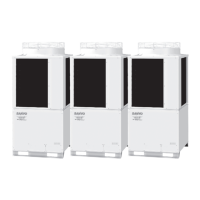Do not twist the remote sensor wiring with the power wiring or run it in the same metal conduit, because this
may cause malfunction.
Install the remote sensor away from sources of electrical noise.
Install a noise filter or take other appropriate action if electrical noise affects the power supply circuit of the unit.
•
•
•
Use an electric junction box (supplied locally) (Fig. 3-73) for flush mounting of the remote sensor.
1. Insert a screwdriver or the like in the groove on the lower side of the remote sensor body to pry off the
back case. (Fig. 3-74)
2. Use the 2 supplied M4 machine screws to secure the remote sensor back case. Prior to mounting,
clear the cutouts in the back case corresponding to the holes in the wall box using a screwdriver or the
like. Use the spacers and take care not to tighten the screws excessively. If the back case will not seat
well, cut the spacers to a suitable thickness.
3. Connect locally supplied 2 core lead wires to the lead wires from the remote sensor. (See “How to wire
the remote sensor.”)
When connecting the locally supplied 2 core lead wires to the terminal block, check the termi-
nal numbers in the indoor unit to make sure that the wires are correctly connected. (Fig. 3-75)
(The remote sensor is damaged if 220 / 240V AC is applied.)
4. Fit the remote sensor to the tabs of the back case and mount it.

